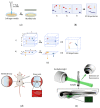Methods to Evaluate Bacterial Motility and Its Role in Bacterial-Host Interactions
- PMID: 35336138
- PMCID: PMC8953368
- DOI: 10.3390/microorganisms10030563
Methods to Evaluate Bacterial Motility and Its Role in Bacterial-Host Interactions
Abstract
Bacterial motility is a widespread characteristic that can provide several advantages for the cell, allowing it to move towards more favorable conditions and enabling host-associated processes such as colonization. There are different bacterial motility types, and their expression is highly regulated by the environmental conditions. Because of this, methods for studying motility under realistic experimental conditions are required. A wide variety of approaches have been developed to study bacterial motility. Here, we present the most common techniques and recent advances and discuss their strengths as well as their limitations. We classify them as macroscopic or microscopic and highlight the advantages of three-dimensional imaging in microscopic approaches. Lastly, we discuss methods suited for studying motility in bacterial-host interactions, including the use of the zebrafish model.
Keywords: bacteria; bacterial motility; bacterial–host interaction; flagella; microscopy; motility methods.
Conflict of interest statement
The authors declare no conflict of interest. The funders had no role in the writing of the manuscript.
Figures

References
-
- Madigan M.T., Clark D.P., Stahl D., Martinko J.M. Brock Biology of Microorganisms. 13th ed. Pearson Prentice Hall; Upper Saddle River, NJ, USA: 2010. Basic Principles of Microbiology; pp. 1–84.
Publication types
Grants and funding
LinkOut - more resources
Full Text Sources

